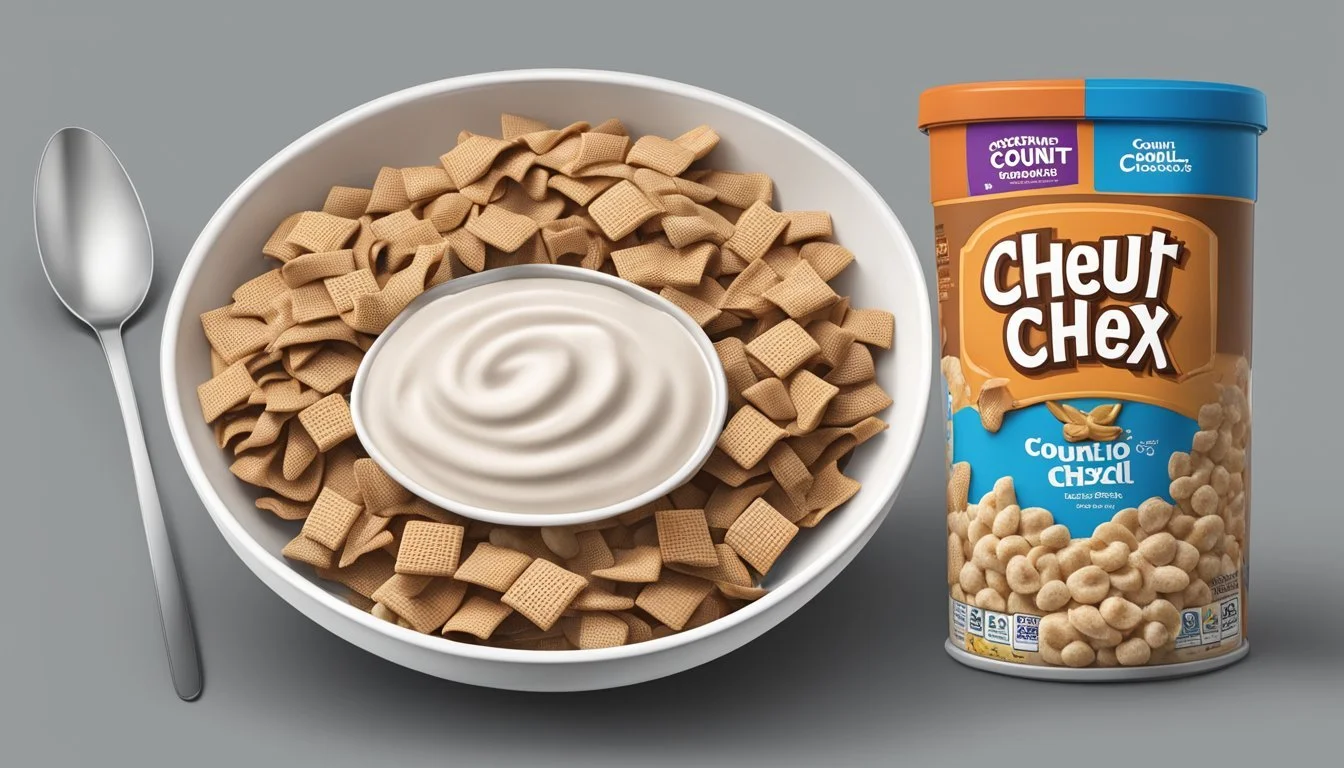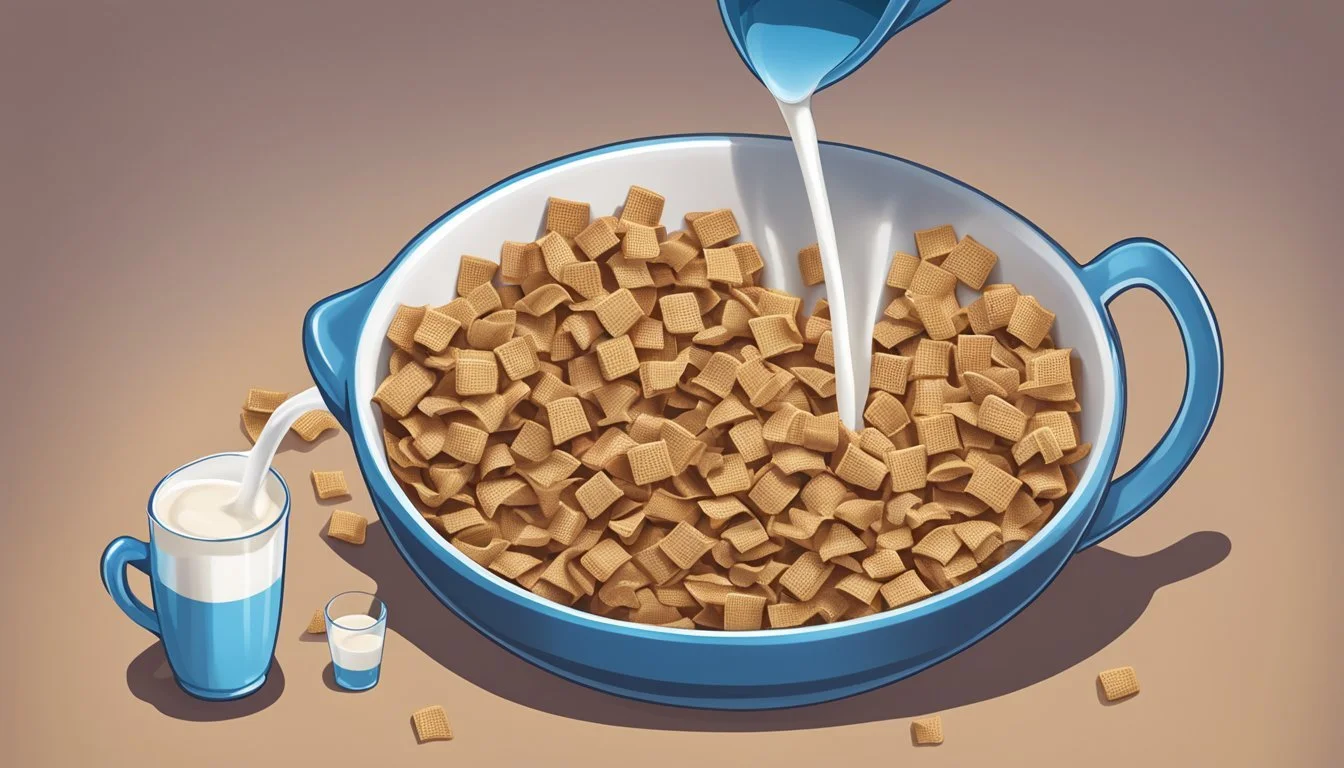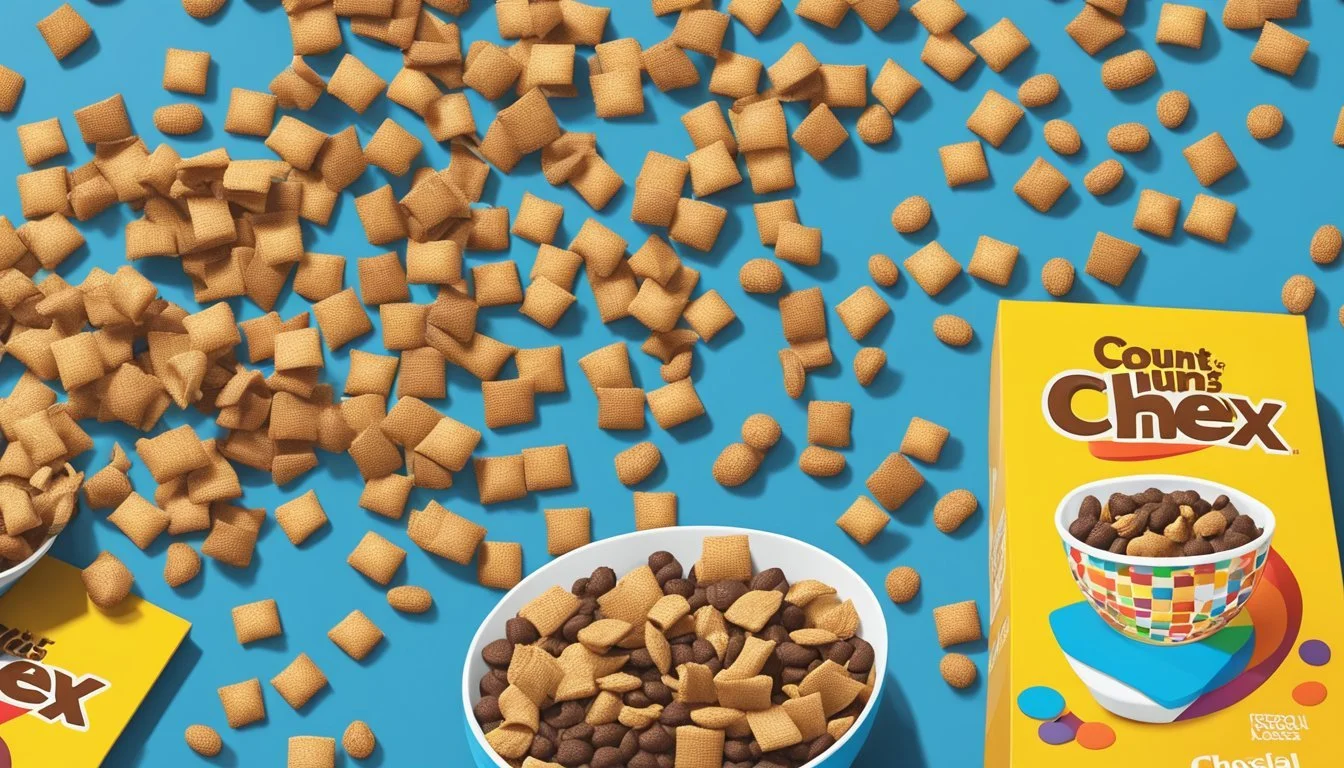Chex vs Count Chocula
Comparing Nutrition and Flavor
This Article is Part of Our Breakfast Cereal Guide with Details on Chex Nutrition and Count Chocula Nutrition
Chex and Count Chocula are two enduring favorites in the breakfast cereal aisle, each offering unique characteristics that cater to different preferences. For those prioritizing health, Chex cereals, notably Rice Chex and Wheat Chex, are often the better choice due to their higher complex carbohydrate content and lower levels of sodium and fat. Rice Chex, for example, boasts 23 grams of complex carbohydrates per serving, while Wheat Chex offers 17 grams—both of which greatly surpass Count Chocula’s 12 grams.
Count Chocula, on the other hand, appeals to those who are more indulgent in their breakfast choices, providing a delightful chocolate flavor and an element of nostalgia dating back to its introduction in 1971. Chocolate-loving cereal enthusiasts might find the 180 milligrams of sodium and 1 gram of fat per serving of Count Chocula to be more acceptable trade-offs for its taste. This makes it a favored option for a treat, rather than an everyday staple.
When comparing Chex and Count Chocula, it's clear they serve different audiences. Chex cereals, made by General Mills like Count Chocula, prioritize nutritional benefits, making them suitable for those looking for a healthier option. Count Chocula provides a more indulgent experience, catering to those who enjoy a sweeter, chocolate-flavored breakfast.
Historical Evolution
Chex and Count Chocula each have distinct origins and histories that have shaped their evolution. Exploring the beginnings of Chex, the creation of Count Chocula, and the legacy of the Monster Cereals provides insight into their enduring popularity.
Origins of Chex
Chex traces its history back to 1937 when it was introduced as "Shredded Ralston" by Ralston Purina. Originally marketed as a health food, it was made from whole grains and boasted a crunchy texture.
The cereal was rebranded as Chex in the 1950s and gained popularity through innovative promotional efforts.
Chex Mix, a combination of cereals and various snack ingredients, emerged in the 1950s, securing the brand’s place in American snack culture. By the 1960s, Chex had established itself as a staple with its unique square form and versatile usage.
Creation of Count Chocula
Count Chocula first appeared on the scene in March 1971, created by General Mills. It was accompanied by Franken Berry, another part of the Monster Cereals line. These cereals were notable for their chocolate and strawberry flavors, respectively, and their iconic monster mascots.
Count Chocula, inspired by Count Dracula, featured chocolate-flavored cereal with marshmallow bits. The character's design aimed to appeal to children with a blend of spookiness and fun.
Marketing campaigns capitalized on the popularity of horror films and Halloween, contributing to the brand's lasting appeal. Boo Berry, introduced in 1972, further expanded the Monster Cereals line.
Monster Cereals Legacy
The Monster Cereals, including Count Chocula, Franken Berry, and Boo Berry, each carved out a special niche in the cereal market. Their seasonal resurgence, particularly around Halloween, has kept them relevant over decades.
General Mills' decision to use movie monsters as mascots was a strategic move. This made the cereals instantly recognizable and fun.
While some Monster Cereals were discontinued, Count Chocula and his cohorts continue to be fan favorites. Their nostalgic value and unique flavors ensure they remain a memorable part of breakfast history.
Product Composition
Understanding the composition of both Chex and Count Chocula cereals can help consumers make informed choices. Each cereal offers a distinct nutritional profile and ingredient list that cater to varying dietary preferences and health considerations.
Chex Ingredients Analysis
Chex cereals are primarily made from whole grains, which contribute to their nutritional value. Corn Chex, for instance, lists corn as its main ingredient. Wheat Chex includes whole grain wheat. This focus on whole grains provides a source of complex carbohydrates and some fiber, although certain variations such as Corn Chex may have minimal dietary fiber.
Key Ingredients:
Whole grain corn or wheat
Sugar
Salt
Vitamins and minerals (e.g., iron, zinc, B vitamins)
Chex products are generally low in sugar, with some like Rice Chex containing as little as 2 grams of sugar per serving. Sodium content can vary, with Corn Chex having 280 milligrams per serving.
Count Chocula Ingredients Breakdown
Count Chocula, known for its distinct chocolate flavor, comprises several unique ingredients. It prominently features whole grain corn and sugars, enriched with a mix of vitamins and minerals. The cereal's defining characteristics are its chocolate flavor and iconic marshmallow pieces.
Key Ingredients:
Whole grain corn
Sugar
Corn syrup
Cocoa
Marshmallows (sugar, corn syrup, modified corn starch)
Vitamins and minerals (e.g., calcium carbonate, iron, B vitamins)
Count Chocula contains about 13 grams of sugar per serving, making it significantly sweeter than Chex. It also includes about 180 milligrams of sodium per serving. The presence of marshmallows adds both flavor and texture but also increases the sugar content.
Nutritional Profiles
When comparing Chex and Count Chocula cereals, understanding their nutritional profiles reveals significant differences in calories, protein, fat, sodium, fiber, and other essential nutrients.
Chex Nutritional Information
Corn Chex offers 120 calories per serving. It contains 2 grams of protein and a minimal 1 gram of dietary fiber. The fat content stands at 0 grams, making it a low-fat option. Corn Chex has 280 milligrams of sodium, which is on the higher side compared to many cereals.
The carbohydrate content is mainly 26 grams, with 3 grams of sugars in each serving. Vitamins and minerals represent a notable aspect, with Vitamin A at 21% of the daily value and Vitamin C at 8%. The cereal lacks potassium, with 0 milligrams per serving.
Count Chocula Nutritional Content
Count Chocula offers 110 calories per serving. It has 1 gram of protein, lower than Chex. Count Chocula contains 1 gram of fat per serving, with 0.2 grams of saturated fat. Sodium levels are 180 milligrams, less than what is found in Corn Chex.
Carbohydrate intake per serving is notably 23 grams, with a high 12 grams of sugars. The fiber content is almost negligible, with 0 grams of dietary fiber. Count Chocula also supplies various vitamins and minerals, though it heavily relies on refined grains and does include some added nutrients such as minor percentages of essential vitamins.
Cultural Impact
Chex and Count Chocula have both made significant cultural impacts, particularly through their advertising efforts and appearances in media and entertainment. Understanding these impacts can highlight the unique positions each holds in the cereal market.
Advertising and Brand Mascots
Count Chocula is famously known for its mascot, Count Chocula, modeled after Count Dracula. This spooky representation ties into a broader monster theme that includes other cereals like Franken Berry and Boo Berry.
The advertising campaigns often featured these characters in Saturday morning cartoons, embedding the brand into the childhood memories of many. Unique commercials included animated segments or even live-action versions, increasing engagement.
Chex, while not featuring spooky monsters, utilized mascots such as Chex Warrior for its Chex Quest game. This approach drew in a different audience, focusing more on adventure rather than horror themes. The Chex Quest game became a cult classic, showcasing the brand's versatility in media.
Cereals in Media and Entertainment
Count Chocula and its fellow Monster Cereals have crossed into broader media and entertainment. They have appeared in various forms from ad integrations in Hollywood films to merchandise like toys and Halloween costumes. These cereals became a staple in American pop culture, especially during the Halloween season.
Chex has a unique presence through its association with the Chex Quest video game, a child-friendly alternative to violent games of its time. This initiative highlighted Chex's ability to innovate and adapt within the entertainment industry, creating lasting impressions among early video game enthusiasts.
Both cereals have left enduring marks on the cultural landscape, each carving out a niche through strategic media appearances and memorable branding efforts.
Consumer Reception
Count Chocula and Chex cereals have uniquely positioned themselves in the minds of consumers. While Count Chocula appeals with its rich chocolate flavor and fun nostalgia, Chex cereals are often chosen for their perceived health benefits and versatility.
Market Performance
Count Chocula and Chex have different market strategies. Count Chocula often sees seasonal demand spikes, particularly around Halloween, driven by its nostalgic appeal. Limited availability can create a sense of urgency among consumers.
Chex, on the other hand, enjoys steady sales throughout the year. Its popularity extends beyond breakfast bowls to include use in homemade snack mixes like Chex Mix. This multi-use characteristic expands its market reach and contributes to consistent performance.
Cereal Ratings and Reviews
Consumers rate Count Chocula high for its indulgent taste and distinctive branding. The cereal's chocolate flavor and marshmallow pieces are frequently praised. Some negative reviews mention high sugar content, raising concerns about its healthiness.
Chex cereals generally receive high ratings for their versatility and nutritional value. Varieties like Wheat Chex and Rice Chex are commended for their whole grain content and crunchiness. Reviews often highlight their suitability for snack recipes. Combatting high sugar cereals, Chex stands out as a preferred choice for health-conscious consumers.
Comparative Analysis
Chex and Count Chocula are two cereals that offer differing experiences. This section will examine their taste and health implications to help readers make an informed choice.
Chex Vs Count Chocula Taste Test
Chex cereals, including Corn Chex and Rice Chex, feature a mild flavor that pairs well with milk. The texture tends to be light and crispy. Count Chocula, on the other hand, has a sweet, chocolatey taste and a crunchier texture, especially when fresh out of the box.
For those who enjoy a less sweet breakfast, Chex might be the better option. Conversely, Count Chocula tends to appeal to those with a sweet tooth, offering a richer, more indulgent flavor.
Health Benefits and Concerns
Sodium and Sugars: Corn Chex contains 280 milligrams of sodium per serving, while Count Chocula has a lower sodium content at 180 milligrams. Both cereals are low in dietary fiber, with 0.0 grams per serving. When it comes to sugars, Count Chocula typically contains more, contributing to its sweeter taste.
Nutritional Content: Chex cereals generally offer a simpler ingredient list and lower sugar content, making them a healthier option for those monitoring their sugar intake. Count Chocula contains added sugars and artificial colors, which can lead to energy spikes and crashes.
Both cereals have their pros and cons. Chex is better for everyday breakfast due to its lower sugar content. Count Chocula is more suited for occasional indulgence due to its higher sugar content.
Variations and Spin-offs
Chex and Count Chocula have expanded their range through a variety of flavors and special editions over the years. These variations cater to different tastes and often include creative collaborations and limited-time releases.
Flavor Varieties
Count Chocula primarily offers a rich, chocolate-flavored cereal with marshmallow bits. Its sister cereals include Franken Berry (strawberry-flavored) and Boo Berry (blueberry-flavored), each with uniquely themed marshmallows.
Chex, on the other hand, boasts a diverse range. These include Rice Chex, Corn Chex, and Wheat Chex. There's also Chocolate Chex for those craving a sweet treat, and Honey Nut Chex for a nutty twist. Despite their indulgence, most variants avoid adding gluten, making them suitable for gluten-free diets.
Special Editions and Collaborations
Both brands frequently release special editions and collaborations, particularly around holidays and film releases. Count Chocula and its counterparts often see limited runs featuring themed marshmallows or seasonal packaging, such as spooky marshmallows for Halloween.
Chex also embraces creativity with products like Chex Mix Hits and Chex Mix Max'd, combining flavors like Buffalo Ranch. These editions sometimes partner with pop culture franchises for unique marketing campaigns, driving interest among diverse consumer groups. The collaboration with Fruity Pebbles brought a blend of fruit flavors that was especially popular.
These frequent variations keep the brands fresh and exciting for consumers, encouraging them to find new favorites and enjoy nostalgic classics.
Availability and Market Presence
Chex cereals and Count Chocula have diverse availability and market presence, affecting where and how consumers find these products. Specific information on retail distribution and international availability provides insight into their market positions.
Retail Distribution
Chex cereals, produced by General Mills, are widely distributed across the United States. They can be found in nearly all major grocery stores, such as Walmart, Target, and Kroger. In addition, Chex is often available in several varieties, including Rice Chex, Wheat Chex, and Corn Chex, catering to various dietary preferences. They also make appearances in cereal bars and breakfast products in schools and institutions.
Count Chocula, another General Mills product, has a more seasonal availability. This cereal typically hits the shelves during the Halloween season, alongside its counterparts Franken Berry and Boo-Berry. Many major grocery stores stock up on these monster-themed cereals during this time, though some online retailers might offer them year-round.
International Availability
Chex cereals have seen international distribution, primarily in countries where General Mills operates. In Canada, for instance, Chex varieties are available in grocery stores and online platforms. The brand also appears in selected markets in Europe and Asia, though not as extensively as in North America.
Count Chocula's international presence is more limited. Due to its seasonal production, it is less commonly found outside the United States. However, collectors and enthusiasts might find them through specialty import shops or international online marketplaces. In contrast, more globally recognized brands like Cheerios and Frosted Flakes have a more robust international market presence, particularly through the Quaker Oats Company's distribution networks.









